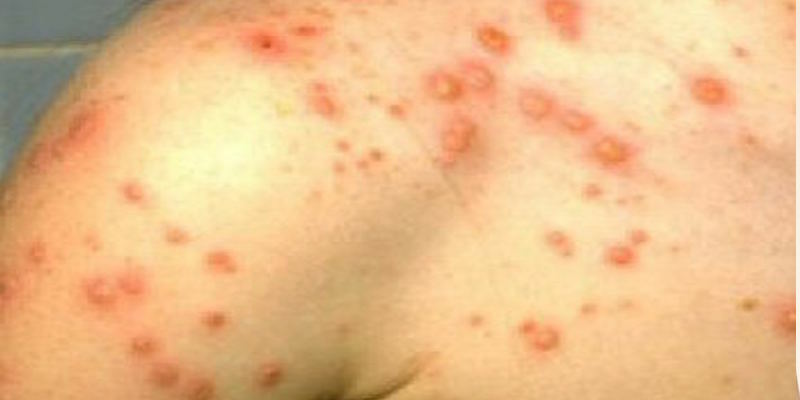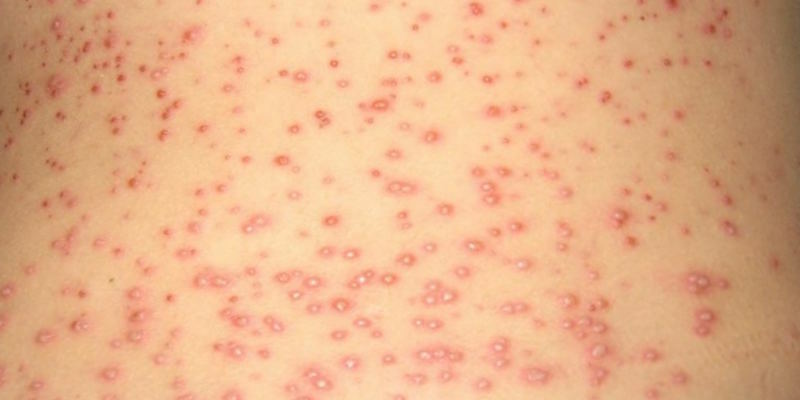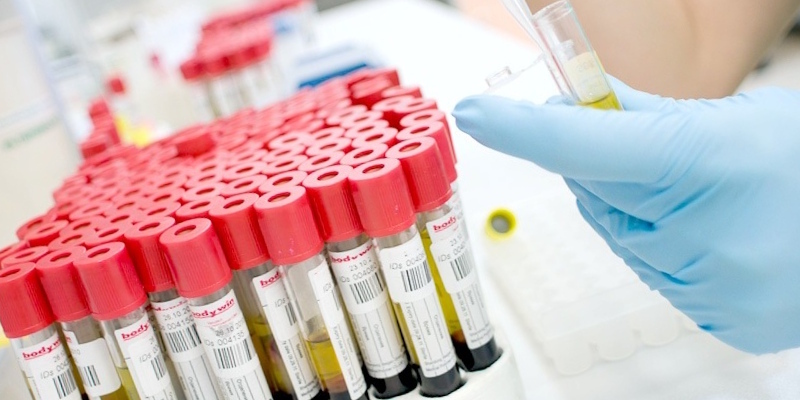
Page contents
- 1 Chickenpox in adults: pathways of infection
- 2 Symptoms of chickenpox in adults
- 3 Types and forms of chicken pox in adult
- 4 Complications of chickenpox in adults
- 5 Treatment of chickenpox in adults
Varicella in adults is rarely diagnosed because it is considered a childinfection. Doctors are sure that it is better to have chickenpox in childhood, because at this age the disease is easier, and after recovery, the body develops persistent immunity, which persists throughout life. In an adult who has not experienced this infection in childhood, the disease is difficult and accompanied by dangerous complications, up to the states that threaten the life of the patient.
Chickenpox in adults: pathways of infection

Chicken pox is a highly infectious viral infection that is acute, with an intoxication of the body and the appearance of a polymorphous rash on the skin. The causative agent is the virus Varicella Zoster, which belongs to a family of herpesviruses that affect only humans. The same virus can cause another viral skin lesion - shingles, since even after recovery Varicella Zoster does not disappear from the body, but remains in the nerve ganglia.
The main transmission routes of infection are airborne and contact. The virus spreads easily through the air, is transmitted by coughing sneezing and talking, can quickly penetrate into neighboring rooms through the ventilation system. Therefore, if there is a patient in the entrance, an adult who has not had chickenpox as a child, the chances of getting infected are very high.
Varicella Zoster is easily incorporated into the body through the upper respiratory tract and the mucous membrane of the eyes. The incubation period of the disease is 10 to 20 days, so it is very difficult to detect the infection in time. All this time an infected person, without knowing it himself, is a danger to the people around him. Particularly vulnerable in this regard are small children and adults who have not previously had chickenpox. During the incubation period, the pathogen is introduced into the blood and lymph, rapidly multiplies and spreads throughout the body.
Susceptibility to the Varicella Zoster virus is very high, so close contact with a sick person turns into a 100% infection. Since chicken pox is very common among children, the main source of infection for adults becomes a sick child or a person with symptoms of herpes zoster.
In spite of the fact that after the transferred illness stable immunity forms, in persons with a weakened immune system, repeated relapses are possible. Only in this case they are manifested by symptoms of herpes zoster, rather than chicken pox. Nevertheless, such a person becomes a source of infection for healthy people who do not previously face the Varicella Zoster virus. According to the ICD-10, chickenpox, which proceeds without complications, passes under code BO1.9.If there are complications, the virus disease is denoted by code BO1.8.
Symptoms of chickenpox in adults

Varicella manifests itself as a characteristic symptom that is difficult to confuse with manifestations of other diseases. In adults, the course of infection has its own characteristics:
- After the incubation period there is a headache, discomfort and aches in the whole body, there is a feeling of weakness, fatigue, general malaise.
- Soon the disease declares itself a sharp rise in temperature to high values (39-40 ° C), itching throughout the body and the appearance of small reddish vesicles with serous contents. Such nodules, slightly elevated above the surface of the skin, soon seize the entire body - from the head to the limbs. At the same time, the skin looks inflamed, hyperemic and edematous. In adults, vysypnye elements often spread not only to the skin, but also to the mucous membranes of the nasopharynx, oral cavity and genital organs.
- Acute period in adults is accompanied by severe fever, severe heat, which can lead to the defeat of an unequal system and symptoms such as photophobia, nausea, vomiting, impaired coordination of movements, convulsions.
- High temperature in adults is difficult to bring down antipyretic agents, it can last for 5 days( in especially severe cases, 7-10 days), after which the body's thermoregulation gradually comes back to normal.
- About 3-4 days after the onset of the disease, the vesicles begin to burst and dry, covered with a dry crust( scab).At the same time, new rashes may appear, as the picture of the disease differs polymorphism. That is, the body of the patient can be present, both fresh rashes of the second wave, and dried up vesicles covered with dense crust, which appeared at the initial stage of the disease. Wavy appearance of rashes is a characteristic feature of chicken pox. On average, new watery vesicles form on the skin for 10 days.
In adults, the formation of rashes is often accompanied by the addition of pyogenic infection. In this case, nodules are not opened for a long time, and after resolution they do not heal well, they become wet and leave unattractive scars behind their skin.
During illness the patient's condition worsens significantly, which experiences constant malaise, severe weakness, headaches and muscle pains. The course of the disease is accompanied by a lack of appetite, a violation of sleep, a constant feverish state - the peak of which, characterized by a sharp rise in temperature, falls on the first day of the infection.
Types and forms of chickenpox in an adult

Two types of disease are distinguished in the classification of varicella: typical and atypical.
In turn, the typical form is divided into several types:
- Light. The acute form of the disease lasts from 2 to 4 days, while the patient's condition is satisfactory. Rashes are uninhabitable, subfebrile( no higher than 38 ° C), no intoxication of the body. The repeated occurrence of rashes stops after three days.
- Average. It is accompanied by heavy rashes, severe itching, marked intoxication of the body, an increase in temperature to 39 ° C.Patients complain of severe weakness, headache, nausea, vomiting, painful aches in the joints and muscles.
- Heavy. The patient's condition is severe, the temperature rises above 40 ° C, severe weakness, headaches, multiple vomiting, which does not bring relief. Abundant rashes cover the entire surface of the body, the likelihood of complications increases. In severe infection, various variants of rashes are possible.
Atypical forms of chickenpox in adults include the following:
- Hemorrhagic. It is accompanied by the appearance of vesicles filled with bloody contents, small hemorrhages under the skin, the appearance of bruising, bleeding gums, an admixture of blood in the vomit, urine and feces. This form of the disease has the most unfavorable prognosis, which is fatal.
- Visceral. It is manifested by high fever, multiple rashes on the skin, mucous membranes, genital organs, strong intoxication of the body.
- When bullous form on the skin of a patient at the same time with characteristic rashes appear large flabby bubbles - bullae filled with serous contents. After their resolution, long-healing ulcers remain on the skin.
- Gangrenous form of chickenpox is rare, mostly in severely malnourished patients with poor care. In this case, infection of the papules occurs with the attachment of a secondary bacterial infection. Around the papules a rim is formed, consisting of necrotic tissues, the patient's condition is complicated by severe heat and general intoxication of the body.
Complications of chickenpox in adults
The main danger faced by an adult when chickenpox is infected is the generalization of the inflammatory process, the damage to the internal organs, and the attachment of a bacterial infection with which the weakened organism can not cope. We list the most common complications of chickenpox in adults:
- development of herpetic stomatitis, in which the rash affects the oral mucosa and the patient has difficulty with eating.
- defeat herpetic rashes of the middle and lower respiratory system with the subsequent development of tracheitis, laryngitis, pneumonia, respiratory failure;
- complications of internal organs - liver( hepatitis) and kidney( nephritis);
- CNS and brain damage - meningitis, encephalitis, cysts of the brain, paresis of limbs;
- affection of the musculoskeletal system - infectious myositis, arthritis;
- dysfunction of the cardiovascular system( myocarditis, thrombophilia);
- consequences of bacterial complications - phlegmon, bullous streptoderma, erysipelas.
In addition, the complications of chickenpox in adults can affect the reproductive system and cause inflammation of the genitals: in men - balanoposthitis, balanitis, in women - vulvitis, vaginitis. After resolving the rashes complicated by a bacterial infection, multiple fine scars remain on the skin, which, when grouped on the face, becomes a significant cosmetic defect.
But a particular danger of chicken pox is for a pregnant woman. Not only does an adult have an extremely serious infection, but its consequences during pregnancy can be very serious - from the risk of interruption, miscarriage, to anomalies in the development and formation of the fetus.
Therefore, if a woman is not sure that she has immunity in chickenpox, formed in childhood, experts advise to go through the necessary diagnostics, which allows to identify antibodies to the virus even at the stage of pregnancy planning. If necessary, immunize against chickenpox no later than 3 months before the expected pregnancy.
If there is a suspicion that an adult has contracted chicken pox, you should immediately seek medical help. Serious complications that often accompany the course of infection in adults can lead to dangerous consequences, and in some cases even result in death.
Diagnostic methods

As a rule, the diagnosis of chicken pox does not cause the specialist difficulties. Suspect the infection allows the characteristic symptoms and features of rashes. Additionally, laboratory diagnostic methods are used:
- general blood and urine analysis;
- is a viroscope method - the contents of vesicles and pustules are examined under a microscope;
- serological method - is aimed at the detection of antibodies to the causative agent of chickenpox - the virus Varicella Zoster. The antibody titer should be examined 7 days after the onset of the disease, again - after 3 weeks. The diagnosis is confirmed if the number of antibodies increases several times.
Similar methods allow to differentiate chickenpox from other diseases with similar symptoms, including pyoderma, streptoderma, rubella, allergic rashes and other pathologies.
Treatment of varicella in adults

The causative agent of chickenpox is a virus, so treating the infection with antibiotics is useless. The main group of medicines in the treatment of chickenpox in adults are antiviral agents that inhibit the DNA of the virus and prevent its further reproduction. Most often, the patient is prescribed such drugs as Acyclovir, Famciclovir or Valaciclovir. The dosage of drugs is selected by a doctor, taking the pill up to 4 times a day.
Antipyretic and anti-inflammatory drugs( Panadol, Ibuprofen) are used to reduce temperature and improve overall health. Antihistamines have a sedative and antipruritic effect( Tavegil, Suprastin, Claritin).
In purulent complications, antibacterial preparations of a wide spectrum of action are prescribed( Cefazolin, Oxacillin).They stop the spread of infection and prevent the formation of pockmarks.
In severe cases, intravenous infusion of detoxification solutions( glucose solution, Reopoliglyukin), whose effect is aimed at reducing the body's intoxication, improving blood circulation and eliminating toxic substances.
A good effect in the treatment of chicken pox in adults is the introduction of a specific immunoglobulin( Zostevir) against the Varicella Zoster virus. It is isolated from the blood of a sick person. Antibodies, which are part of this drug bind the causative agent of the disease, accelerate its excretion from the body and promote recovery.
Physiotherapeutic methods( UFO) are used to accelerate the healing, formation and disappearance of dry crusts covering the vysypnye elements.
Recommendations

In addition, during the illness the patient must observe the following recommendations:
- It is necessary to limit communication with other people, observe bed rest, avoid physical exertion.
- To accelerate the withdrawal of toxins, increase the amount of fluid consumed. It is best to drink berry fruit, fruit compotes, green and herbal teas with lemon and honey.
- In an acute period, it is not necessary to wet the rash. With the relief of the condition, you can take a warm shower, but do not steal or rub your skin, so as not to break the formed dry crust.
- Eruptions should be treated several times a day with antiseptic solutions( a weak solution of potassium permanganate, boric acid, furacillin).After bathing, the skin should be slightly soaked with a soft towel, and then pinpoint the antiseptic and treat with an external agent with anti-inflammatory and analgesic effect( Fenistil gel, zinc ointment).When there is a purulent complication, it should be applied to the rashes of the ointment with antibacterial component.
Vysypnye elements can be treated and other solutions with antiseptic action( green, Castellani liquid, fucarcine).During the treatment it is necessary to monitor the cleanliness of the skin and bed linen, which should be changed as often as possible. With severe itching, do not comb the affected skin, as it is easy to bring a secondary infection. Purulent foci that arise due to infection are difficult to treat, they slowly heal and leave behind ugly pockmarks( post-scarlet scars), which strongly spoil the appearance.
Folk remedies

Chickenpox is especially difficult for adults with reduced immunity. Therefore, at home, it is possible to supplement the basic treatment with safe and tested folk remedies, whose action is aimed at increasing the body's resistance to a viral infection.
During an acute period, it is recommended to drink more vitaminized beverages that will accelerate the elimination of toxins. It can be berry juice, broth of wild rose, compote of fresh apples or dried fruits, as well as green or herbal tea with lemon and honey. It is useful at night to drink a glass of warm milk with a small spoon of honey or eat during the day, 500 g of blueberries, which have a good immunomodulatory effect.
You can prepare every morning fresh vitamin from the fresh orange and celery root and drink it before breakfast or squeeze the lemon juice, mix it with a liter of boiled water and 1 tbsp.l.honey and drink this drink throughout the day.
If rashes have appeared even on the oral mucosa, rinses with a decoction of sage, chamomile, calendula and other medicinal herbs with antiseptic and anti-inflammatory properties are recommended.
At the stage of healing of rashes it is useful to take medicinal baths with the addition of a solution of soda, vinegar, celandine infusions, calendula or essential oils( bergamot, tea tree).Such water procedures lasting no more than 5 minutes will help to dry out the rash and speed up the healing of the skin.
Features of nutrition

The course of varicella in an adult is accompanied by a deterioration in the general condition, nausea, lack of appetite. Therefore, during this period, it is necessary to exclude from the diet heavy, fatty, fried, high-calorie food, to refuse marinades, seasonings, pickles and fresh vegetables with coarse fiber( radishes, turnips, cabbage).It should be remembered that an excess of sweets and carbohydrate food contributes to the multiplication of pathogenic bacteria, which can lead to the attachment of bacterial infection and purulent complications.
The patient must comply with an easy milk and vegetable diet, eat boiled dietary meat, light vegetable and cereal soups, cereals, fresh fruit, steamed and steamed vegetables. In the diet must be a sour milk drink, boiled or braised fish.



